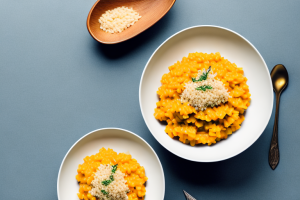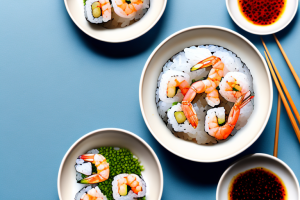How to stir-fry wild rice with shiitake mushrooms and snow peas
8 min read
A pan of stir-fried wild rice with shiitake mushrooms and snow peas
Are you tired of your regular rice dishes and are looking for a healthy, yet flavorful alternative? Well, wild rice is your answer! Paired with shiitake mushrooms and snow peas, this dish is not only delicious but also packed with a plethora of health benefits.
The health benefits of wild rice, shiitake mushrooms, and snow peas
Wild rice is an excellent source of vitamins and minerals, including manganese, phosphorus, and magnesium. It is also high in antioxidants and fiber, making it an ideal addition to a healthy diet. Shiitake mushrooms, on the other hand, are known for their rich umami flavor and contain compounds that can boost the immune system and reduce inflammation. In addition, snow peas are low in calories and high in nutrients, such as vitamin C and vitamin K, which promote healthy bones and skin.
Furthermore, wild rice, shiitake mushrooms, and snow peas are all great sources of plant-based protein. Wild rice contains around 6 grams of protein per cooked cup, while shiitake mushrooms provide about 2 grams of protein per 100 grams. Snow peas are also a good source of protein, with around 2.5 grams per cooked cup. Incorporating these three ingredients into your meals can help you meet your daily protein needs, especially if you follow a vegetarian or vegan diet.
Techniques for preparing wild rice for stir-fry
Before stir-frying wild rice, it is essential to rinse it thoroughly under cold water. This process helps to remove any dirt or debris and prevent any bitterness. Next, you can either soak the rice overnight or cook it in a rice cooker or on the stovetop until tender. Once cooked, let it cool slightly before adding it to the stir-fry.
Another important tip for preparing wild rice for stir-fry is to add some flavor to it. You can do this by cooking the rice in broth instead of water or adding some herbs and spices to the cooking water. This will infuse the rice with additional flavor and make it more delicious. Additionally, you can also add some vegetables or protein to the stir-fry to make it a complete meal. Some great options include mushrooms, bell peppers, chicken, or tofu.
How to select and clean shiitake mushrooms for stir-fry dishes
When selecting shiitake mushrooms, look for firm and plump caps with a slightly dry, but not cracked surface. Avoid any mushrooms that are slimy or have wrinkles. Once you’ve purchased your mushrooms, clean them by wiping them with a damp paper towel or a soft brush. Do not wash them as they can absorb too much water and become mushy during cooking.
Shiitake mushrooms are a great source of nutrients and have been used in traditional medicine for centuries. They contain compounds that have been shown to boost the immune system and have anti-inflammatory properties. In addition to their health benefits, shiitake mushrooms have a rich, savory flavor that makes them a popular ingredient in stir-fry dishes.
When cooking with shiitake mushrooms, it’s important to slice them thinly and cook them over high heat to bring out their flavor. They can be added to stir-fry dishes towards the end of cooking, or sautéed with garlic and ginger for a simple side dish. With their unique texture and flavor, shiitake mushrooms are a versatile ingredient that can add depth and complexity to a wide range of dishes.
Tips for selecting fresh and crisp snow peas for stir-frying
When selecting snow peas, look for pods that are bright green and firm. Avoid any peas that are yellow or have black spots. Additionally, check that the peas make a snapping sound when broken, which indicates freshness. Before stir-frying, remove the tips and strings from the snow peas.
Another important factor to consider when selecting snow peas for stir-frying is the size of the pods. Choose smaller pods as they tend to be sweeter and more tender than larger ones. Larger pods can be tough and have a bitter taste. It’s also a good idea to buy snow peas that are in season, as they will be at their peak freshness and flavor.
Choosing the right oil for stir-frying wild rice with shiitake mushrooms and snow peas
For the best flavor and aroma, use peanut oil, vegetable oil, or sesame oil for stir-frying. These oils have a high smoke point, meaning they can handle high heat without burning, which is essential for stir-frying. Start by heating the oil in a wok or a large skillet and add the vegetables in stages, starting with the ones that take the longest to cook.
It’s important to note that different oils have different flavors and can affect the overall taste of your dish. Peanut oil has a nutty flavor that pairs well with Asian-inspired dishes, while sesame oil has a distinct, rich flavor that can add depth to your stir-fry. Vegetable oil, on the other hand, has a neutral flavor that won’t overpower the other ingredients. Consider the flavor profile you want to achieve when choosing your oil for stir-frying.
The perfect seasoning blend for your stir-fry dish
The ideal seasoning blend for a wild rice stir-fry dish includes garlic, ginger, soy sauce, and rice vinegar. These ingredients provide a balance of salty, sweet, and sour flavors that complement the earthy wild rice, umami mushrooms, and fresh snow peas. Be mindful of the portion size because over-seasoning can overwhelm the dish.
For an added kick of heat, you can also include a small amount of red pepper flakes or Sriracha sauce to the seasoning blend. This will give your stir-fry dish a spicy kick that pairs well with the other flavors. However, be cautious not to add too much as it can overpower the other flavors in the dish. Experiment with different amounts to find the perfect balance of heat and flavor for your taste buds.
The secret to achieving a perfectly cooked wild rice texture in your stir-fry dish
The key to having perfectly cooked wild rice is to use a 2:1 ratio of water to rice and a tight-fitting lid when cooking. Start by adding the rice and water to a pot and bringing it to a boil. Then, reduce the heat and let it simmer for 40-50 minutes until tender. Let the rice sit for a few minutes before fluffing it with a fork or a spatula.
Another important tip to keep in mind when cooking wild rice is to rinse it thoroughly before cooking. This helps to remove any debris or dirt that may be present on the rice. Additionally, you can add some salt or other seasonings to the water to enhance the flavor of the rice.
Wild rice is a great addition to stir-fry dishes as it adds a nutty and chewy texture to the dish. To incorporate it into your stir-fry, cook the rice separately and then add it to the stir-fry towards the end of the cooking process. This ensures that the rice retains its texture and doesn’t become mushy.
How to stir-fry shiitake mushrooms without overcooking them
To avoid overcooking shiitake mushrooms, add them to the wok or skillet once the vegetables have cooked for a few minutes. This way, they have enough time to absorb the flavors of the other ingredients without becoming too soft or mushy. Stir-fry for 2-3 minutes until they are fully cooked and slightly browned.
Another tip to keep in mind when stir-frying shiitake mushrooms is to slice them evenly. This ensures that they cook evenly and at the same rate. Additionally, you can add a splash of soy sauce or oyster sauce to enhance the umami flavor of the mushrooms. Serve as a side dish or add to a stir-fry with your favorite protein and enjoy!
Achieving a crispy texture in your snow peas while stir-frying
To achieve a crispy texture for snow peas, stir-fry them quickly over high heat and avoid overcooking them. In addition, make sure to spread them out in the pan and avoid crowding them. Crowding can cause the snow peas to steam and turn limp instead of being crispy.
Another tip to achieve a crispy texture in your snow peas is to blanch them in boiling water for about 30 seconds before stir-frying. This will help to remove any excess moisture and ensure that the snow peas cook evenly. After blanching, immediately transfer the snow peas to a bowl of ice water to stop the cooking process and preserve their bright green color. Then, pat them dry with a paper towel before stir-frying.
Adding protein to your wild rice, shiitake mushroom, and snow pea stir-fry dish
If you want to add protein to your dish, you can either stir-fry chunks of chicken, beef, tofu, or shrimp separately and combine them with the vegetables or add them to the wok or skillet in the middle stages of stir-frying. Make sure the protein is fully cooked before incorporating it into the dish.
Another great way to add protein to your stir-fry dish is by including nuts or seeds. Cashews, almonds, peanuts, and sesame seeds are all great options that can add a delicious crunch to your dish while also providing protein. Simply add them to the wok or skillet towards the end of the stir-frying process and toss them with the vegetables and rice. Not only will this add protein, but it will also add some healthy fats and extra flavor to your dish.
Serving suggestions and garnish ideas for your stir-fry dish
This dish pairs well with steamed white rice or egg noodles. Garnish with chopped scallions, toasted sesame seeds, or lemon wedges for added freshness and flavor. For a pop of color, you can also add sliced red bell peppers or grated carrots to the stir-fry.
If you want to add some protein to your stir-fry, consider adding sliced chicken breast, shrimp, or tofu. Simply cook the protein separately and add it to the stir-fry towards the end of cooking. This will give your dish an extra boost of flavor and nutrition.
If you’re looking for a way to make your stir-fry dish even healthier, try using brown rice instead of white rice. Brown rice is a whole grain that is higher in fiber and nutrients than white rice. You can also add more vegetables to your stir-fry, such as broccoli, snow peas, or bok choy, to increase the nutritional value of your meal.
How to store leftover stir-fried wild rice, shiitake mushroom, and snow pea dish
Store any leftover stir-fried wild rice, shiitake mushroom, and snow pea dish in an airtight container in the refrigerator for up to three days. When reheating, add a tablespoon of water to the dish and cover it with a lid or a microwave-safe plastic wrap to prevent the rice from drying out.
It’s important to note that reheating the dish in a microwave may result in uneven heating. To ensure that the dish is heated evenly, stir the rice and vegetables halfway through the reheating process. Additionally, if you plan on freezing the dish, it’s best to store the rice and vegetables separately to prevent the rice from becoming mushy when thawed. Simply reheat the rice and vegetables separately and combine them once they are heated through.
Variations of the recipe – substituting vegetables or spices
You can switch up the vegetables in this dish with asparagus, bok choy, or bell peppers. Additionally, you can add chili flakes or oyster sauce to the stir-fry for added heat or depth of flavor.
Enjoy your delicious, healthy, and easy-to-make wild rice, shiitake mushroom, and snow pea stir-fry dish!


